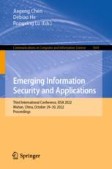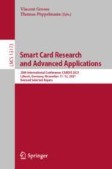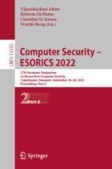Search
Search Results
-
A Tightly Secure ID-Based Signature Scheme Under DL Assumption in AGM
Identity-based signatures (IBS) can be verified using the signer identity information as the public key, and hence, there is no need for certificate...
-
On the Tight Security of TLS 1.3: Theoretically Sound Cryptographic Parameters for Real-World Deployments
We consider the theoretically sound selection of cryptographic parameters, such as the size of algebraic groups or RSA keys, for TLS 1.3 in practice....

-
Artificial Intelligence for the Design of Symmetric Cryptographic Primitives
This chapter provides a general overview of AI methods used to support the design of cryptographic primitives and protocols. After giving a brief...
-
Efficient IBS from a New Assumption in the Multivariate-Quadratic Setting
Since its introduction in 1984, identity-based signature (IBS) schemes have been studied in different settings. But, there are very few constructions...
-
An overview of cryptographic primitives for possible use in 5G and beyond
This survey overviews the potential use of cryptographic primitives in the fifth-generation mobile communications system (aka 5G) and beyond. It...
-
Delegating Supersingular Isogenies over \(\mathbb {F}_{p^2}\) with Cryptographic Applications
Although isogeny-based cryptographic schemes enjoy the smallest key sizes amongst current post-quantum cryptographic candidates, they come at a high...
-
STEAC: Towards secure, traceable, and efficient cryptographic access control scheme in smart healthcare
Smart Healthcare (SHC) plays an increasingly greater role in improving the quality of health care, which has been widely concerned by researchers,...

-
Hierarchical Identity Based Inner Product Functional Encryption for Privacy Preserving Statistical Analysis Without q-type Assumption
Statistical analysis is a popular research tool used by scientists, industries, and governments to summarize data in a meaningful way. It is an...
-
Hardware Obfuscation of AES IP Core Using PUFs and PRNG: A Secure Cryptographic Key Generation Solution for Internet-of-Things Applications
Intellectual Property (IP) core has evolved into a primary component of System-on-Chip (SoC). They address and implement a wide range of hardware...

-
FuzzyKey: Comparing Fuzzy Cryptographic Primitives on Resource-Constrained Devices
Implantable medical devices, sensors and wearables are widely deployed today. However, establishing a secure wireless communication channel to these...
-
Cryptographic Building Blocks
This chapter introduces basic cryptographic mechanisms that serve as foundational building blocks for computer security: symmetric-key and public-key...
-
Optimized threshold implementations: securing cryptographic accelerators for low-energy and low-latency applications
Threshold implementations have emerged as one of the most popular masking countermeasures for hardware implementations of cryptographic primitives....

-
Implementation of RSA cryptographic algorithm using SN P systems based on HP/LP neurons
Asymmetric cryptographic systems are often more complex and require more computational power than symmetric systems. This is why they might be...

-
Sequential Digital Signatures for Cryptographic Software-Update Authentication
Consider a computer user who needs to update a piece of software installed on their computing device. To do so securely, a commonly accepted ad-hoc...
-
Pseudorandom functions in NC class from the standard LWE assumption
The standard Learning with Errors (LWE) problem is associated with a polynomial modulus, which implies exponential hardness against quantum or...

-
Breaking the Quadratic Barrier: Quantum Cryptanalysis of Milenage, Telecommunications’ Cryptographic Backbone
The potential advent of large-scale quantum computers in the near future poses a threat to contemporary cryptography. One ubiquitous usage of...
-
Quantum Lightning Never Strikes the Same State Twice. Or: Quantum Money from Cryptographic Assumptions
Public key quantum money can be seen as a version of the quantum no-cloning theorem that holds even when the quantum states can be verified by the...

-
Does Fiat-Shamir Require a Cryptographic Hash Function?
The Fiat-Shamir transform is a general method for reducing interaction in public-coin protocols by replacing the random verifier messages with...
-
A Usability Study of Cryptographic API Design
Software developers interact with cryptographic components via APIs provided by a cryptographic library to protect sensitive information such as...
-
Use of cryptography in malware obfuscation
Malware authors often use cryptographic tools such as XOR encryption and block ciphers like AES to obfuscate part of the malware to evade detection....

